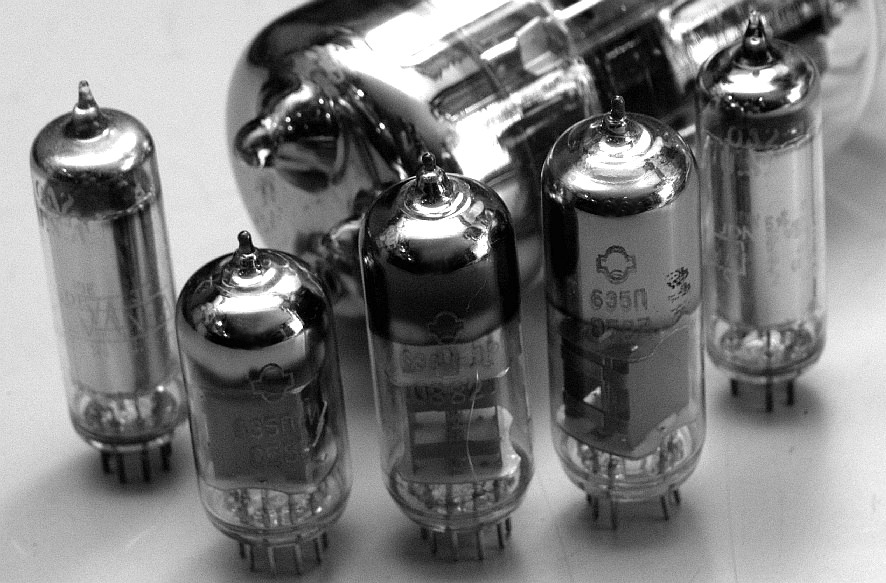Rerurn to Romy the Cat's Site
In the Forum: Melquiades Amplifier
In the Thread: The one-stage Melquiades.
Post Subject: The 6E5P-E vs 6E5P.Posted by Romy the Cat on: 4/29/2007
 hagtech wrote: hagtech wrote: |
| Stepping back a moment, I'm guessing this tube is designed for radar operation. Maybe in an aircraft. The spec sheet definately talks only about pulse mode of operation. Maybe it was a driver for a pulse radar transmitter? What this means to me is that there are some sacrifices made in the tube. It has a very limited maximum average power dissipation. This had to be done in order to keep the structure small enough that it would operate at the desired RF frequencies. It has very high pulse current capability, so the cathode must have extremely high emission, or plate gets starved and curves fall over. |
|
Jim, I think you look at different datasheet. The 6E5P never meant to be used for pulse operation. The Datasheet said that it was designed for broadband amplification of HF.
http://www.goodsoundclub.com/PDF/6E5P.pdf
The 6E5P was use in railway radios transmitters, in portable SW radio stations, in some consumer radios in 60s and reportedly in TV applications. The 6E5P did have a version specialty dedicated for impulse operation. It called 6E5P-E. It has visibly the same constriction but extra short balloon:
http://www.goodsoundclub.com/PDF/6E5P-E.pdf
A few years ago I foolishly bought 100 of them (I think I paid 8c per tube) and they turned out to be VERY different sonically then the 6E5P and I found them unusable (about which I warned in the Melquiades article). BTW, you might see them on the picture:

The number 2 on the left in the first row is the 6E5P-E. The number 4 on the left in the first row is a normal 6E5P.
 hagtech wrote: hagtech wrote: |
| So I have an idea. For class A operation, the cathode emission is way too high. We cannot run at the high peak currents because the plate will melt. Or at least overheat and cause secondary emission problems, glow, etc. Therefore, I suggest starving the filament. Let's think about running this tube with 5V heater. I'll run some sweeps to see what happens to the curves. I think adapting the tube from pulse operation to continuous mode is no problem. The lower emission is still enough for our needs, and it has the side benefit of greatly increasing lifetime. |
|
Well, sine there is not need to fight with impulse mode I do not think it is the problem. However, the idea to starve filaments I very interesting. For LF horns I would need the full 6.wW on plate but for HF horns I need a fraction of watt and I might drop the heater voalsh, prolonging the tube lives. I will also make some Dima’s voltage vs. current tests (BTW, I found it VERY cool approach) with lover heater voltages.
 hagtech wrote: hagtech wrote: |
| Most importantly, I think we have to keep the plate dissipation way down, like 6W or so. Cannot let the G2 get too hot. |
|
In my experiment I would say that up to 6.8W it behaved reasonably and more or less proportionally increase power with inverse voltage. I have to note that went I drove my 109dB upper bass horn with minus 10dB digital off my 5V DACK at 13:1 and having 6.6W on 6E5P’s plate then I took a think blanket and patched the mouth of my horns because it sounded louder then civil defense bombing alarm. I presumed that it offset the horns resonant frequency quite aggressively but it was the only way to test it under the live condition. With a “tampon” in the mouth that horn would be too violent to be with it in the same room.
 hagtech wrote: hagtech wrote: |
| I like the direction you are headed. This tube will sound better and more natural than the 6C33. But might lack "authority". |
|
Well with 109dB sensitively there are very many rational to go into the direction I ma going… how it will manifest itself in Sound I have no idea. I personally less care about “lack of authority". It is 109dB and I need just 0.7 V to pump into my speaker to get listening level. I more concern about ability of this single tube (and it is VERY fast tube) to play “slow” and produce the necessary “acoustic like” and “dynamically viscose” harmonic pattern. It did it with two stages but I do not know if it will with single stage. The individual channel looked like sound fine but how it will be in context of the whole installation only God knows…
The caTRerurn to Romy the Cat's Site